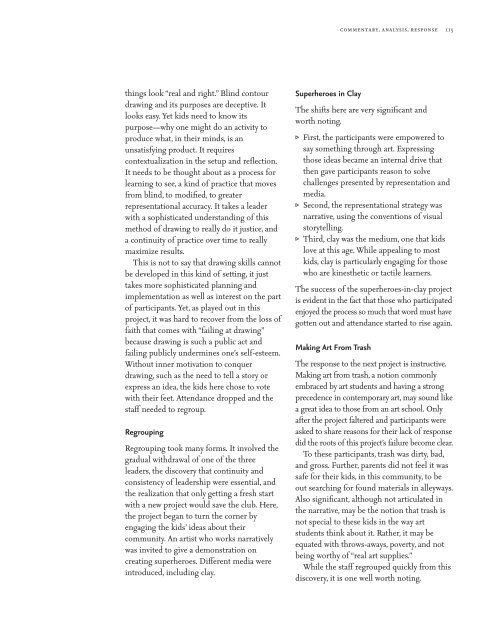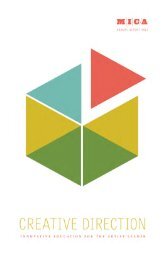art/vision/voice - Maryland Institute College of Art
art/vision/voice - Maryland Institute College of Art
art/vision/voice - Maryland Institute College of Art
Create successful ePaper yourself
Turn your PDF publications into a flip-book with our unique Google optimized e-Paper software.
things look “real and right.” Blind contour<br />
drawing and its purposes are deceptive. It<br />
looks easy. Yet kids need to know its<br />
purpose—why one might do an activity to<br />
produce what, in their minds, is an<br />
unsatisfying product. It requires<br />
contextualization in the setup and reflection.<br />
It needs to be thought about as a process for<br />
learning to see, a kind <strong>of</strong> practice that moves<br />
from blind, to modified, to greater<br />
representational accuracy. It takes a leader<br />
with a sophisticated understanding <strong>of</strong> this<br />
method <strong>of</strong> drawing to really do it justice, and<br />
a continuity <strong>of</strong> practice over time to really<br />
maximize results.<br />
This is not to say that drawing skills cannot<br />
be developed in this kind <strong>of</strong> setting, it just<br />
takes more sophisticated planning and<br />
implementation as well as interest on the p<strong>art</strong><br />
<strong>of</strong> p<strong>art</strong>icipants. Yet, as played out in this<br />
project, it was hard to recover from the loss <strong>of</strong><br />
faith that comes with “failing at drawing”<br />
because drawing is such a public act and<br />
failing publicly undermines one’s self-esteem.<br />
Without inner motivation to conquer<br />
drawing, such as the need to tell a story or<br />
express an idea, the kids here chose to vote<br />
with their feet. Attendance dropped and the<br />
staff needed to regroup.<br />
Regrouping<br />
Regrouping took many forms. It involved the<br />
gradual withdrawal <strong>of</strong> one <strong>of</strong> the three<br />
leaders, the discovery that continuity and<br />
consistency <strong>of</strong> leadership were essential, and<br />
the realization that only getting a fresh st<strong>art</strong><br />
with a new project would save the club. Here,<br />
the project began to turn the corner by<br />
engaging the kids’ ideas about their<br />
community. An <strong>art</strong>ist who works narratively<br />
was invited to give a demonstration on<br />
creating superheroes. Different media were<br />
introduced, including clay.<br />
commentary, analysis, response 115<br />
Superheroes in Clay<br />
The shifts here are very significant and<br />
worth noting.<br />
v First, the p<strong>art</strong>icipants were empowered to<br />
say something through <strong>art</strong>. Expressing<br />
those ideas became an internal drive that<br />
then gave p<strong>art</strong>icipants reason to solve<br />
challenges presented by representation and<br />
media.<br />
v Second, the representational strategy was<br />
narrative, using the conventions <strong>of</strong> visual<br />
storytelling.<br />
v Third, clay was the medium, one that kids<br />
love at this age. While appealing to most<br />
kids, clay is p<strong>art</strong>icularly engaging for those<br />
who are kinesthetic or tactile learners.<br />
The success <strong>of</strong> the superheroes-in-clay project<br />
is evident in the fact that those who p<strong>art</strong>icipated<br />
enjoyed the process so much that word must have<br />
gotten out and attendance st<strong>art</strong>ed to rise again.<br />
Making <strong>Art</strong> From Trash<br />
The response to the next project is instructive.<br />
Making <strong>art</strong> from trash, a notion commonly<br />
embraced by <strong>art</strong> students and having a strong<br />
precedence in contemporary <strong>art</strong>, may sound like<br />
a great idea to those from an <strong>art</strong> school. Only<br />
after the project faltered and p<strong>art</strong>icipants were<br />
asked to share reasons for their lack <strong>of</strong> response<br />
did the roots <strong>of</strong> this project’s failure become clear.<br />
To these p<strong>art</strong>icipants, trash was dirty, bad,<br />
and gross. Further, parents did not feel it was<br />
safe for their kids, in this community, to be<br />
out searching for found materials in alleyways.<br />
Also significant, although not <strong>art</strong>iculated in<br />
the narrative, may be the notion that trash is<br />
not special to these kids in the way <strong>art</strong><br />
students think about it. Rather, it may be<br />
equated with throws-aways, poverty, and not<br />
being worthy <strong>of</strong> “real <strong>art</strong> supplies.”<br />
While the staff regrouped quickly from this<br />
discovery, it is one well worth noting.
















